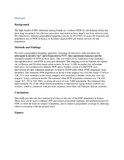| dc.description.abstract | The high burden of HIV infections among female sex workers (FSW) in sub-Saharan Africa has been long recognised, but effective preventive interventions have largely not been taken to scale. We undertook a national geographical mapping exercise in 2011/2012 to assess the locations and population size of FSW in Kenya, to facilitate targeted HIV prevention services for this population.
METHODS AND FINDINGS:
We used a geographical mapping approach, consisting of interviews with secondary key informants to identify "hot" spots frequented by FSW, their operational dynamics and the estimated numbers of FSW in those spots. This was followed by validation of the estimates through interviews with FSW at each spot identified. The mapping covered Nairobi, the capital city of Kenya, and 50 other major urban centres. In total, 11,609 secondary key informant interviews were conducted to identify FSW spots. Further, a total of 6,360 FSW were interviewed for spot validation purposes. A total of 10,670 spots where FSW congregate were identified. The estimated FSW population in all the towns mapped was 103,298 (range 77,878 to 128, 717). Size estimates in the towns mapped were extended to smaller towns that were not mapped, using a statistical model. The national urban FSW population estimate was 138,420 (range 107, 552 to 169, 288), covering all towns of over 5,000 population. We estimated that approximately 5% of the urban female population of reproductive age in Kenya could be sex workers, which is consistent with previous estimates from other sub-Saharan African countries.
CONCLUSIONS:
This study provides the first national level data on the size of the FSW population in Kenya. These data can be used to enhance HIV prevention programme planning and implementation for FSW, to form the basis for impact evaluations, and to improve programme coverage by directing efforts to locations with the greatest need. | en_US |
| dc.description.department | a
Department of Psychiatry, University of Nairobi, ; bDepartment of Mental Health, School of Medicine,
Moi University, Eldoret, Kenya | |

